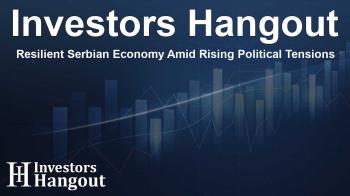Resilient Serbian Economy Amid Rising Political Tensions

Serbia's Economy Shows Resilience in Challenging Times
In the face of overwhelming protests, Serbia finds itself at a crossroads. Demonstrators are voicing their discontent following a tragic incident where the roof of a train station in Novi Sad collapsed, leading to the loss of 15 lives. This has sparked widespread unrest, with significant public action demanding accountability and change within the government.
The most recent protests saw thousands of individuals block key roads, notably in Kragujevac. These demonstrations, primarily led by university students, have emerged as a powerful expression of public dissatisfaction and have escalated into a broader movement aimed at the ruling Serbian Progressive Party (SPP).
Youth Protests Demand Action and Accountability
These student-led protests have galvanized a substantial section of the population, quickly transforming from localized student concerns into a significant national movement. Protesters seek in-depth investigations into the train station's collapse, demanding those responsible are held accountable.
Critics of the government have expressed serious concerns regarding the erosion of democratic practices, media freedom, and the concentration of power, particularly within President Aleksandar Vu?i?'s administration. Unlike previous demonstrations, which have often been portrayed as partisan or influenced by external forces, the government finds it challenging to discredit the authenticity of the current protests.
As described by prominent regional politicians, these protests signify a substantial shift. A Croatian Member of the European Parliament remarked on the unique nature of the discontent, emphasizing its evolution into a mass civic movement indicative of a larger societal commitment to activism.
Economic Outlook Amidst Political Unrest
Despite these challenges, the economic outlook for Serbia remains relatively positive. Reports indicate that the country is experiencing a robust economic environment, with projections suggesting that GDP growth is set to rise significantly in the coming years. Key financial analysts have highlighted Serbia's stable macroeconomic indicators and well-managed fiscal policies.
The predicted economic growth trajectory includes expectations of a leap from a forecasted 3.9% in 2024 to approximately 4.2% by 2025, continuing to 4.4% in 2026. These optimistic assessments have been bolstered by affirmations of Serbia's credit ratings, emphasizing a healthy policy mix supportive of continued growth.
Government's Mixed Response to Unrest
In reaction to the turmoil, the government’s strategy has been a blend of dismissive rhetoric and attempts to delegitimize the protests. Officials have suggested that the demonstrations are part of a larger, externally funded agenda aimed at destabilizing the nation.
This narrative seeks to undermine the organic grassroots nature of the protests, framing them instead as an organized effort by foreign entities. Enhanced media control and minimal acknowledgment of the protests in state-aligned channels further illustrate the government's strategy to manage public perception.
Public Demands for Effective Institutions
The core demand emerging from the protests is not merely political leadership change but the establishment and functionality of Serbian institutions that the public funds and relies on. Scholars and citizens alike have drawn parallels between the current climate and the oppressive era of former leader Slobodan Miloševi?, highlighting fears that without reform, the cycle of government dysfunction will continue.
The sentiment is clear: citizens desire effective governance that addresses their needs rather than merely deferring to existing power structures. This insistence on institutional reform speaks volumes about the public's resolve and the expectations placed on those in power.
Continued EU Observations and Cautions
The European Union remains engaged but cautious, monitoring the developments while advocating for the right to peaceful assembly. Some critics argue that the EU's reluctance to take a firm stance reflects a prioritization of stability over true democratic processes, particularly given Serbia’s strategic role within the region.
Serbia's importance to the EU can be viewed through the lens of its industrial capacity and resource wealth, particularly with its reserves of essential materials for advancing green technologies. Analysts indicate that the EU’s ‘wait and see’ approach, although measured, raises questions about its commitment to democratic ideals.
Frequently Asked Questions
What sparked the recent protests in Serbia?
The protests were ignited by the tragic collapse of a train station roof, resulting in the loss of lives, which led citizens to demand accountability and reforms.
What are the protesters demanding?
Protesters seek a thorough investigation into the train station incident, accountability for those responsible, and institutional reforms.
How is Serbia's economy performing amidst these protests?
Despite political unrest, Serbia's economy is showing strong growth prospects, with GDP growth projected to rise in the coming years.
What is the government's response to the protests?
The government has used a mix of dismissive rhetoric and accusations against the protesters, attempting to portray them as influenced by foreign entities.
What does the future hold for Serbia's political landscape?
Calls for institutional reform among the populace indicate a desire for a shift towards effective governance, which could reshape Serbia's political landscape moving forward.
About The Author
Contact Olivia Taylor privately here. Or send an email with ATTN: Olivia Taylor as the subject to contact@investorshangout.com.
About Investors Hangout
Investors Hangout is a leading online stock forum for financial discussion and learning, offering a wide range of free tools and resources. It draws in traders of all levels, who exchange market knowledge, investigate trading tactics, and keep an eye on industry developments in real time. Featuring financial articles, stock message boards, quotes, charts, company profiles, and live news updates. Through cooperative learning and a wealth of informational resources, it helps users from novices creating their first portfolios to experts honing their techniques. Join Investors Hangout today: https://investorshangout.com/
The content of this article is based on factual, publicly available information and does not represent legal, financial, or investment advice. Investors Hangout does not offer financial advice, and the author is not a licensed financial advisor. Consult a qualified advisor before making any financial or investment decisions based on this article. This article should not be considered advice to purchase, sell, or hold any securities or other investments. If any of the material provided here is inaccurate, please contact us for corrections.

